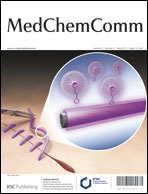A bivalent ligand targeting the putative mu opioid receptor and chemokine receptor CCR5 heterodimer: binding affinity versus functional activities†
Abstract
Opioid substitution and antiretroviral therapies have steadily increased the life spans of AIDS patients with opioid addiction, while the adverse


 Please wait while we load your content...
Please wait while we load your content...